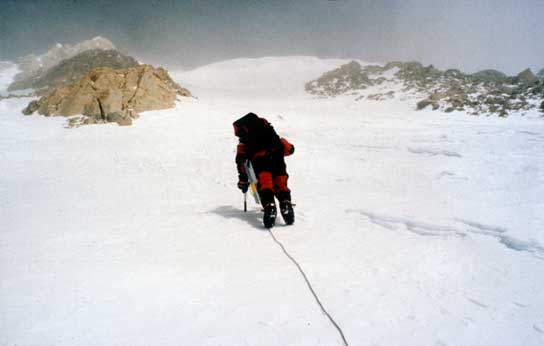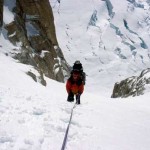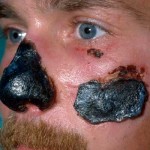
Nothing could have prepared me for what the freezing cold of Alaska can do. I had just experienced the best 17 days climbing in my life, but the 18th cost me dear. Frostbite and exposure nearly killed me, but a dramatic mountain rescue saved my life, and began a journey I will never be able to forget…
Though not the highest mountain in the world, Mt. McKinley ranks as one of the hardest to climb. Its difficult approach and unpredictable weather makes it one of the biggest challenges in mountaineering. It stands 20,320ft above sea level and dominates the Alaska Range of mountains. It was the combination of these factors along with the physical challenge, which attracted me to the mountain. The mountain was named after president McKinley in 1896 although he never actually saw the mountain. The Indian peoples call it Denali or The High One. First climbed in 1913, McKinley still proves a difficult challenge. In 1999, 1183 climbers attempted the climb with 508 reaching the summit. A success rate of only 43% It was at a dinner party in autumn 1998 that the seeds were sown for the climb.
With my climbing partners Steven Ball and Antony Hollinshead the expedition took over six months of planning, commitment and training. Fitness and stamina play an important part of the physical aspect but there is much more to expeditions than just these. Hours of telephone calls and e-mails to sponsors, the Alaskan authorities and each other followed by weekends of climbing, organising and packing. It is this preparation, which can make or break an expedition. In late April 1999 we finally left for Alaska.
Situated at 7000ft above sea level base camp lies just off the main flow of the Kahiltna Glacier. All flights into the range land here on the glacier airstrip depositing their passengers onto the icy desert. Two mountains dominate the skyline, Mt. Hunter and Mt. Foraker. Both are also served by the same camp, which bursts into life late April as the first climbers arrive. The American Parks Ranger Service has a permanent presence all season registering climbers onto the range and advising on routes and conditions. From here an evening weather forecast is sent out to everyone on the range.
Eleven miles of glacier and crevasse awaited us before we arrived at the base of the West Rib. Crevasses are deep cracks in the glaciers surface and can be hundreds of feet deep. To fall down one can mean severe injury or even death. Unlike most other mountain ranges in the world there are no porters in Alaska. You have to carry all your own equipment. Towing a sledge laden with supplies as well as carrying a large rucksack is hard work. We all carried 120lbs each, or the weight of two bags of cement. Everything for the 25 day round trip had to come with us: – food, clothes, tents, climbing gear, radio, camera equipment…
It took six days to reach the base of the mountain.
Rising over 12,000ft in less than three miles the West Rib is a challenging route. First climbed in 1959 it takes about twelve days to reach the summit. The first obstacle is a 1200ft gulley of snow and ice followed by undulating snow and rock ridges. The scenery is spectacular and the fiery sunsets seem to last forever. Clear days allowed us views of distant mountains over 100 miles away. After ten days of climbing we established our high camp at 16,300ft. It had been a difficult climb demanding extreme physical effort and stamina, along with mental strength and perseverance. On the evening of 18th May the weather forecast was for light winds and gentle snow on the summit. Tomorrow would be summit day.
With 4000ft to climb summit day was a long hard push, but we carried much less weight and made steady progress. The sky was clear and by early evening we walked onto the summit plateau. The wind had picked up battering ice and snow into our faces. With only a few hundred yards to go we pushed on into the ferocious wind. Only 300yds from the summit we were forced to dig a snowhole into the ice. The temperature had plummeted far below freezing and it was impossible to continue. All night we lay in the hole. Steve became hypothermic, both Anthony and myself hugged him all night to keep him warm. Though so close the summit was now a world away.
By morning the wind had dropped, our freezing night was over. I had radioed base camp to be told that rescue was 2-3 days away. It seemed up to us to rescue ourselves. We tried to walk back to camp but I was severely frostbitten in both my feet and hands. With skill and patience Steve and Anthony steered me along the way home, but it was useless. I could not walk. Steve went on for help leaving Anthony and myself sheltering on the plateau. Hours past with no sign of rescue, it looked as if we would spend another night on the mountain. All we could do was sit and wait. Just as we were giving up hope a helicopter appeared out of the blue and flew the two of us down to base camp. It was the most wonderful journey of my life; the feeling of relief is indescribable, but Steve was now left alone on the mountain.
When the body is exposed to extreme temperatures it can suffer frostbite. The arteries freeze and stop the flow of blood to the body’s tissues. Fingers, toes and face are the first to be affected, but if the freezing is severe then hands and feet may also be damaged. Although medical advances have come a long way in recent years the best treatment is still to allow the body to recover itself as best as it can. This is a slow and painful process but does allow the damage to be kept to a minimum. Any tissue that does not recover slowly turns black and dies. Due to the extensive freezing of my extremities I lost all my toes, length off every finger and suffered facial scarring.
I spent a night in intensive care before the reality of my situation struck me. All my fingers and toes had been frozen solid along with my nose and left cheek. No one can tell what the damage will be; all you can do is wait. Anthony had been lucky and suffered less severe freezing. Steve came to hospital a day later and was severely hypothermic and frostbitten. He had fallen on his attempt to get help and spent a night out alone in the snow, with both legs broken and hands and feet frostbitten. The next few days were heartbreaking and painful. My fingers began to recover a little but it became apparent my toes were dead. I looked on helpless as they slowly turned from pink to black. The expedition had ended leaving all of us injured for life.
 After two weeks in Alaska we were allowed home. Steve and myself spent another nine weeks in Nottingham City Hospital Burns Unit. Anthony was allowed home as an outpatient.
I lay in bed over two months before I could stand again. I had to re-learn many of the things we all take for granted, such as walking, writing and feeding myself. I learned to adapt to my new life quickly but the recent months have been very difficult.
Physical scars are visible, mental scars are not. My life has changed forever, but in my mind my old body still survives. However, it will take more than just time to heal the mental scars.
After two weeks in Alaska we were allowed home. Steve and myself spent another nine weeks in Nottingham City Hospital Burns Unit. Anthony was allowed home as an outpatient.
I lay in bed over two months before I could stand again. I had to re-learn many of the things we all take for granted, such as walking, writing and feeding myself. I learned to adapt to my new life quickly but the recent months have been very difficult.
Physical scars are visible, mental scars are not. My life has changed forever, but in my mind my old body still survives. However, it will take more than just time to heal the mental scars.
The gallery below has a selection of pictures from the trip, but beware..! There are graphic images of Frostbite…























Hello! This was an incredible read and admittedly very helpful as I’m writing about a character who suffers from frostbite. I was wondering, did your hands and feet have any scarring due to the frostbite aside from amputation? Could you tell me what it looks like?
Sorry if this comment comes off as insensitive— I’m having a really hard time finding healed frostbite injuries for reference, and I don’t want to be inaccurate in my writing.
I did see you said you were still climbing, which is such a delight to hear! Safe travels!
MR.Nigel
It was great reading your story.
And What an story!
Incredible that you guys survived that ordeal really..
Dispite your injurys you are really blessed.
I hope you are well.
Greetings from Iceland
Sincerely
Bjarni Vilhjalmsson
Thank you Bjarni. We had quite a ride, but have come out the other end and continue on life adventure. I’ve travelled to Iceland quite a few times since then, travelling and also ski touring in Greenland…
I’ve read and studied many survival stories and yours is very special. It’s great to see all of the team survived and are living life to it’s fullest. Do you have any regrets? I’m curious. Thanks again for sharing your amazing story.
No regrets Jeff, although i’d be delighted to have my finger and toes back. Life throws many challenges our way and we learn a great deal from them. This is why I choose to educate youngsters using my expereinces.
Hey Nigel, Have you all returned to climbing, or did you give it up? I’d imagine, given the severity of your collective injuries, going back to climbing would have been a bit of a challenge?
Hi Martin, Ive been across the world climbing many times since. Its not easy and very painful at times, but I love it.
That was an amazing survival story, thank you for sharing such an inspirational experience.
I just love the episode on i shouldnt be alive, the best one of all the series.
Thanks from sweden
Thank you Erik. Today is 21 years since we flew to Alaska and I’m filming a series of interviews about the climb. They’ll be on my website and the usual Social Network Channels…
You and your climbing buddy’s will to live is strong ! Others have died there . All 3 of you survived against incredible odds that was against all of you. It takes something like this for one to realize how fragile life truly can be and to not take it for granted as in years past. Life and death on peaks like McKinley are a sharp thin edge. Some don’t make it , you and your friends did. A life lesson learned.
Pingback: Antarctica NZ Field Trainers’ Cold Environment Medicine session 12 September 2018 – pre reading material |
Thank you for recommending my blog. If I can help in any way, please feel free to ask…
I just wanted to know since i live near the equator how does frostbite feel like or gangrene if you had to describe it?
Hi Abdulla,
Thats quite a question to answer..! When you get very cold, the pain of the injury leaves you. You feel as if you’re in a dream like world and time passes very quickly. Your fingers look like ivory and are as hard as stone. When you finally warm up, the pain is almost impossible to bear. Everything throbs and medical treatment is a must. Over time, your injuries turn red, then purple and finally black. They resemble granite and amputation is the only outcome.
Before I had my fingers amputated I managed to work with them quite well. Even in their contorted and hard state, I could still type and spent many hours writing about my experiences.
I didn’t get Gangrene as I was treated in a good hospital, but it can appear with frostbite injuries. I hear the smell is awful.
I hope this helps answer your question.
Regards
Nigel
I’m so sorry that happened to you and your friends ;-(
Thank you Joy. It was a terrible time for us all, but we’re still living life to the full..!
Amazing story of survival. I see that you lost the tip of your nose. Are you able to get plastic surgery for that or are you just leaving it as is? I hope you and your friends are doing well.
Thank you for your comment. I had a skin graft to replace my nose which worked very well. Tissue was used from my forehead and it’s survived -40C..!
Dear Nigel sir,
I really like to read your story,, what incredible story. Is really pleasure to read. I have show some about your have been asking to TV mountain. If anything I can help to please contact me. It would be great to help and involve with it.. I wish best of luck to you… And take care .
Best Regard
Gumbo Sherpa Tamang x